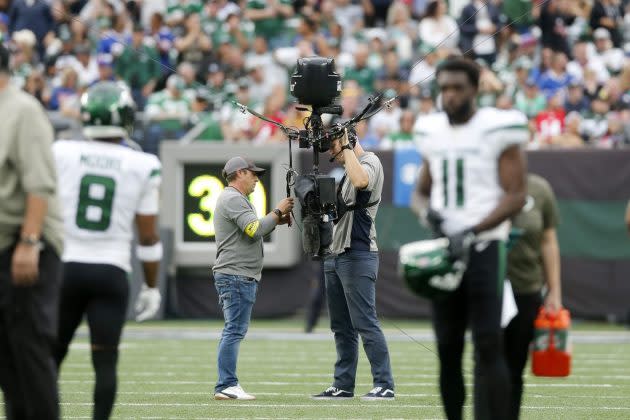Rodgers’ Jets Arrival Means TV Primetime and Green for Gang Green

The New York Jets are ready for their fall TV close-up, as Aaron Rodgers’ long-awaited jump to the AFC East has set the stage for Gang Green’s return to the national airwaves.
Forty days after Rodgers first announced his intention to transfer his talents from Green Bay to East Rutherford, the Packers have traded the veteran QB for what amounts to a handful of draft picks. In closing the deal, the Jets have picked up a four-time MVP while all but ensuring that they’ll be a regular fixture on the NFL’s national TV circuit.
More from Sportico.com
The last time the Jets played more than one-third of their games in front of a coast-to-coast audience was back in 2011, when Rex Ryan’s crew appeared in seven national NFL broadcasts. Of these, five games aired in primetime, with the remainder being featured in CBS’ late Sunday afternoon window. That season followed on the heels of the Jets’ 24-17 loss to the Steelers in the AFC Championship Game, which drew a record 54.9 million viewers on CBS.
While the NFL isn’t expected to unveil its 2023 TV schedule until May 11, the networks began scrambling to accommodate the new-look Jets in mid-March, when Rodgers revealed his post-Darkness Retreat plans during an appearance on The Pat McAfee Show. Having already submitted their 2023 wish lists to the NFL in the lead-up to Super Bowl LVII, network execs were quick to request additional Jets games as soon as it became apparent that Rodgers was dead set on making the leap to the nation’s No. 1 media market.
If primetime was all the rage in 2011, the smart money has this Rodgers-helmed Jets team showing up in a fair amount of 4:20 p.m. ET national games on CBS and Fox. After all, Sunday afternoons are when the NFL draws its biggest audiences; together, the two broadcasters averaged more than 24 million viewers per game in the relatively uncluttered late window. By comparison, NBC’s Sunday Night Football served up an average linear-TV audience of 18.7 million viewers per game in the far more competitive primetime slot.
In swapping shades of green, Rodgers will go a long way towards helping the NFL’s media partners rake in some bonus escarole. Given that advertisers already had to dig deep to buy time in nationally televised Packers games—last season, the average unit cost for a commercial that aired during Rodgers’ 10 appearances on CBS/Fox/NBC was around $900,000 a pop—imagine the cost of reaching all those high-earning households in New York City, North Jersey, Southwestern Connecticut and the Mid-Hudson region.
Networks have been circling around upcoming Jets matchups including an away game against Dallas, a MetLife Stadium showdown against their Big Blue co-tenants and a string of home outings (Bills, Eagles, Chargers, Chiefs). However the TV chips fall, the Jets are certain to enjoy an overdue spike in visibility; as it happens, New York’s AFC rep last season did not make a single appearance in a national TV broadcast. Such has been the case since Ryan packed up his dress sweats and headed for Buffalo; in the last 10 years, the Jets have played in exactly one national Sunday broadcast on one of the Big Three networks.
And national TV is just the beginning. Thanks to Rodgers, the local affiliates can expect to reap the benefits of a big ratings surge as well. After closing out 2022 as the lowest-performing NFL franchise for the third straight year—the Jets posted a 7.0 household rating in the home DMA, down a tick from a 7.1 the previous season—the team can expect a TV turnout that’s more commensurate with its big-market status. If nothing else, the Jets should at least catch up to the Giants’ local TV numbers; last year, Gang Green averaged 987,893 viewers per game, or 28% fewer impressions than Big Blue’s 1.37 million.
As much as the Jets are understandably leery of reliving the events of Brett Favre’s 2008 season, things were actually looking pretty hunky-dory before the transfer sustained an injury that effectively turned his throwing arm into a $12 million novelty item. In fact, while Favre’s season in New York is now largely mis-remembered as a blown opportunity, you’d have to be a real glass-half-empty type to believe that his 9-7 campaign wasn’t a huge improvement over the previous year’s 4-12 run. In any event, Favre’s time under center helped springboard the Jets to the national stage, a place of prominence the team wouldn’t relinquish for the next couple of seasons.
Favre’s time in New York was transformative. A month before taking his first snap as a Jet, the wily old gunslinger’s No. 4 shattered the NFL’s single-day record for jersey sales. Fans couldn’t wait to see Favre in action, as 10,000 diehards showed up to witness him go through the motions of his first no-pads practice. More to the point, once the season got underway, ratings (and ad revenue) soared. That’s what the Jets (and the networks) are hoping will happen as soon as Rodgers’ plane touches down in Newark.
The Jets haven’t made the playoffs since that long-ago loss to Pittsburgh; as such, the team now enjoys the dubious distinction of maintaining the longest active postseason drought in all of U.S. professional sports. (New York succeeds the Los Angeles Kings, who just weeks ago snapped a tough-luck streak that had gone back to 2005-06.) Rodgers doesn’t need to win a Super Bowl in New York, he just needs to give the fans something to believe in. And yes, a playoff berth would be nice. But in the near term, the greatest impact he’s likely to have will be on the fall TV schedule.
(This story has updated the headline)
Best of Sportico.com
